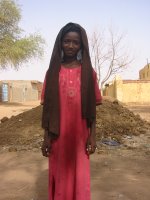I left the hotel at 6 a.m. to take the flight to El Fasher. There are nice-looking UN jets at the airport but it is the African Union planes that curry soldiers and civilians to Fasher each day. It was a peculiar feeling to be standing in line with soldiers and the procedures for checking in were completely different – like a stripped down version of airport service. You get clearance at an AMIS building in downtown Khartoum, which involves (literally) piling all of your luggage on top of one another on a single scale in order to check for the 25 pound limit. We waited for about 45 minutes until everyone had been cleared, then put our own luggage on the back of a truck where we were then shuttled to the airport. At the airport we had to change vans once again, and then we had to put our own luggage in the back cargo hold of the 28-person flight.
The flight took a little over an hour. By the time we were descending to land at the Fasher airport, the image of a vast expanse of Sudanese desert – artificially familiar to me through its presence in the media – was everywhere in sight. As we traveled closer, you could make out the huts of residents (like Mongolian yurts, but with thinner cloth) and lean-twos. It looked as if we might land in the sand but the runaway emerged at about the point that we touched down and the pilot hit the brakes- hard.
Getting our bags was the reverse of boarding the plane and the group of us traveling together helped with locating and lifting luggage out of cargo. The UNDP van was waiting for us. This vehicle is less than a year old, and it is in pristine condition. Apparently, traveling by vehicle has become so dangerous in Sudan (67 UN vehicles have been hijacked in 2007 so far) that most staff travel by plane.
El Fasher is a world unto itself. I have been to many exotic places – Pakistan, Mongolia – but I have never entered a world where everything around me was utterly different. The first thing I noticed when I disembarked was that it was cooler in Fasher than in Khartoum. It was only 33 degrees, since rain had arrived the day before. And the breeze was cool and refreshing, as opposed to harsh and punishing in Khartoum.

El Fasher is an ancient city and the residents include not only people, but goats, camels and horses. The structures are a mixture of cement, brick and plant materials. Men and women are wearing indigenous clothing- there is simply no Western clothing to be seen, excepting for the occasional aid worker. Between the airport and downtown Fasher – a drive of about 10 minutes – there is one main road. On this road one can see signs of humanitarian and aid organizations still operating here. There were 180 organizations working in Darfur last year, and nearly 15,000 aid workers were registered. This number has decreased somewhat as some organizations have begun to pull out, but they are still pretty high. For large camps, one key humanitarian organization is responsible for service delivery.
There is a curfew in Darfur – there has been since 1992. All residents are advised to be indoors as of 8:30. Shootings do occur regularly, and have intensified recently, we were told. There is also a strong Sudanese military presence. Open trucks with soldiers and rifles regularly patrol for no apparent reason. Some of the trucks are equipped with sub-machine guns. Apparently the uniforms of armed personnel can vary, making it sometimes difficult to know if someone in uniform is the police or military. I passed a female officer of some kind when I was grabbing my lunch in the market. She was definitely unfriendly.
Although officially no picture taking is allowed, I was told that it should be okay as long as you don’t photograph a sensitive area and have the courtesy to ask others if taking a picture is all right.
